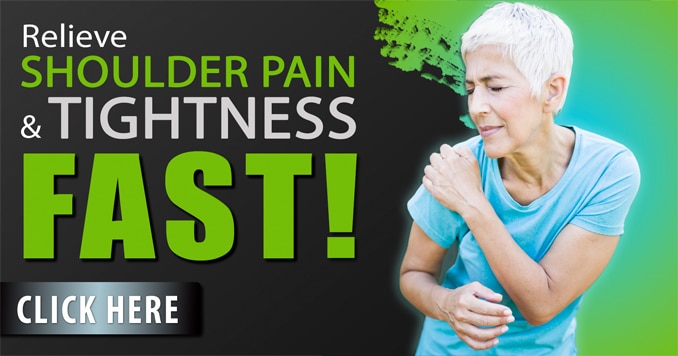
Does your shoulder cause your elbow pain? Many people fail to realize that some common pains in the arm can be caused by a different joint – like the shoulders.
I got an excellent question from a Fixing Elbow Pain customer, “How does the shoulder affect your elbow pain?”
The Elbow is Like the Knee
The elbow is very much like the knee. It ends up being at the mercy of the shoulder.
If you look at the knee, the knees end up being at mercy to the hip. A lot of times when there are:
- hip issues
- hip weakness
- hip tightness
- hip injury
All of that ends up harming the knees.
The same thing ends up happening in the elbow when there is:
- weakness
- poor activation
- tightness
- poor movement patterns
This all ends up affecting the elbow, putting greater strain on the elbow leading to pain, leading to injury, and slowing down recovery from injury.
3 Things in the Shoulder that Affect the Elbow
Now three things that I look at in the shoulder that have a big impact on the elbow are:
- Scapular Stabilizer Muscles
- Pushing Movements
- Pulling Movements
1. Look at the Scapular Stabilizers
When it comes to Scapular Stabilizers, I want to look and see how those shoulder blades are when people are exercising or moving.
Are those shoulder blades flat against the thoracic spine (mid-back)? Or do they end up winging so the medial border of the scapula (shoulder blade) ends uplifting or even the bottom part of the scapula ends up tilting up?
If I get winging of the scapula, let’s say with pushing movements, pressing movements, overhead, or diagonal pattern movements, it’s my cue that I need to work on the scapular muscles. And I need to look at working on the activation, endurance, and strength of those scapular muscles. I will use what I cover up in the Scapular Stabilization Exercise Program to help with this problem.
2. What Happens with Rowing Movements?
The second thing that I end up looking at is how the client is when it relates to rowing movements.
Looking at the rowing movements, the rowing movements should end up coming from the shoulders.
If they end up having a poor position in their shoulders, the wrists and elbows play more of a role when it comes to rowing or pulling movements. And if they have good posture, the rowing movement comes from the shoulders with the elbows and wrists assisting.
If I see collapsing in the shoulders, wrists, and elbows as the primary things working, then I need to work on fixing this. Either there is a weakness or a motor pattern issue that I need to address.
3. Looking at Pushing Movements
The third thing I will end up looking at is I want to look and see how things look when it relates to pushing movements. I can end up looking at the push-up as an example. This exercise will highlight things regarding the scapular muscles and will also end up helping to see if there is excess stress and strain on the elbows.
I can have them do the push-up movement. What will end up happening is if the elbows gravitate out more, there will be more stress on the elbows. If the elbows end up being closer to the body, there will be less stress on the elbow. If they end up activating and bringing in the latissimus dorsi (lats) into the pushing or push-up movement, there will be less stress on the elbow.
Push Up Self Test
A little self-test that I will ask my clients to do is to relax their abdominal area, stay weak in the shoulders, and go through a wall push-up or push-up movement and ask how they end up feeling in the elbows.
And then I will end up asking them to build tension in those lats and bring the elbows down.
Then I ask, which way was better on your elbows?
If it feels like their shoulder and back are doing more work, there is less stress on the elbows.
Wrap Up
Please look and see how you are regarding the rowing (pulling) movements with you and your clients. Look at the scapular muscles to see if the shoulder blades stay nice and flat during pushing and diagonal movements. And then, take a look and see how you are regarding the pushing movements. If you end up having a client with elbow pain or if you end up having elbow pain, take a look at those three things.
That is it. Take care and bye-bye.
Rick Kaselj, MS


